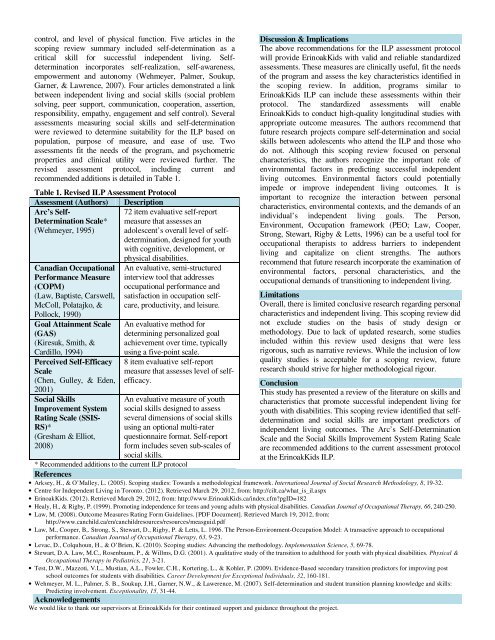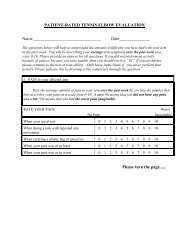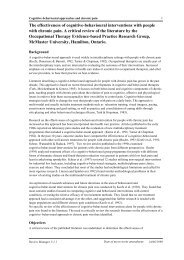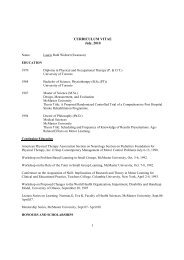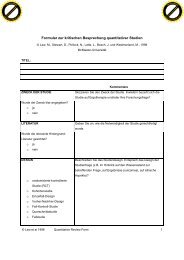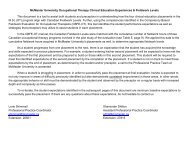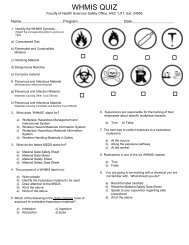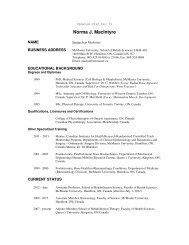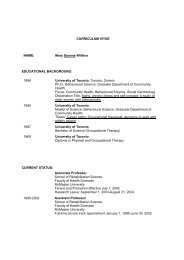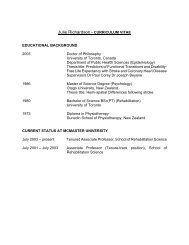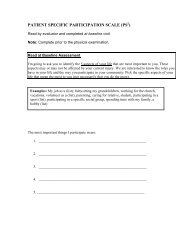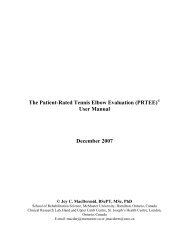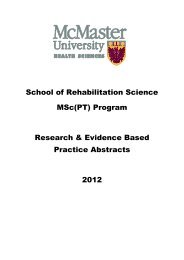Evidence Based Practice Symposium - McMaster University
Evidence Based Practice Symposium - McMaster University
Evidence Based Practice Symposium - McMaster University
Create successful ePaper yourself
Turn your PDF publications into a flip-book with our unique Google optimized e-Paper software.
control, and level of physical function. Five articles in the<br />
scoping review summary included self-determination as a<br />
critical skill for successful independent living. Selfdetermination<br />
incorporates self-realization, self-awareness,<br />
empowerment and autonomy (Wehmeyer, Palmer, Soukup,<br />
Garner, & Lawrence, 2007). Four articles demonstrated a link<br />
between independent living and social skills (social problem<br />
solving, peer support, communication, cooperation, assertion,<br />
responsibility, empathy, engagement and self control). Several<br />
assessments measuring social skills and self-determination<br />
were reviewed to determine suitability for the ILP based on<br />
population, purpose of measure, and ease of use. Two<br />
assessments fit the needs of the program, and psychometric<br />
properties and clinical utility were reviewed further. The<br />
revised assessment protocol, including current and<br />
recommended additions is detailed in Table 1.<br />
Table 1. Revised ILP Assessment Protocol<br />
Assessment (Authors) Description<br />
Arc’s Self-<br />
72 item evaluative self-report<br />
Determination Scale* measure that assesses an<br />
(Wehmeyer, 1995) adolescent’s overall level of selfdetermination,<br />
designed for youth<br />
with cognitive, development, or<br />
physical disabilities.<br />
Canadian Occupational An evaluative, semi-structured<br />
Performance Measure interview tool that addresses<br />
(COPM)<br />
occupational performance and<br />
(Law, Baptiste, Carswell, satisfaction in occupation self-<br />
McColl, Polatajko, &<br />
Pollock, 1990)<br />
care, productivity, and leisure.<br />
Goal Attainment Scale An evaluative method for<br />
(GAS)<br />
determining personalized goal<br />
(Kiresuk, Smith, & achievement over time, typically<br />
Cardillo, 1994)<br />
using a five-point scale.<br />
Perceived Self-Efficacy 8 item evaluative self-report<br />
Scale<br />
measure that assesses level of self-<br />
(Chen, Gulley, & Eden,<br />
2001)<br />
efficacy.<br />
Social Skills<br />
An evaluative measure of youth<br />
Improvement System social skills designed to assess<br />
Rating Scale (SSIS- several dimensions of social skills<br />
RS)*<br />
using an optional multi-rater<br />
(Gresham & Elliot, questionnaire format. Self-report<br />
2008)<br />
form includes seven sub-scales of<br />
social skills.<br />
* Recommended additions to the current ILP protocol<br />
Discussion & Implications<br />
The above recommendations for the ILP assessment protocol<br />
will provide ErinoakKids with valid and reliable standardized<br />
assessments. These measures are clinically useful, fit the needs<br />
of the program and assess the key characteristics identified in<br />
the scoping review. In addition, programs similar to<br />
ErinoakKids ILP can include these assessments within their<br />
protocol. The standardized assessments will enable<br />
ErinoakKids to conduct high-quality longitudinal studies with<br />
appropriate outcome measures. The authors recommend that<br />
future research projects compare self-determination and social<br />
skills between adolescents who attend the ILP and those who<br />
do not. Although this scoping review focused on personal<br />
characteristics, the authors recognize the important role of<br />
environmental factors in predicting successful independent<br />
living outcomes. Environmental factors could potentially<br />
impede or improve independent living outcomes. It is<br />
important to recognize the interaction between personal<br />
characteristics, environmental contexts, and the demands of an<br />
individual’s independent living goals. The Person,<br />
Environment, Occupation framework (PEO; Law, Cooper,<br />
Strong, Stewart, Rigby & Letts, 1996) can be a useful tool for<br />
occupational therapists to address barriers to independent<br />
living and capitalize on client strengths. The authors<br />
recommend that future research incorporate the examination of<br />
environmental factors, personal characteristics, and the<br />
occupational demands of transitioning to independent living.<br />
Limitations<br />
Overall, there is limited conclusive research regarding personal<br />
characteristics and independent living. This scoping review did<br />
not exclude studies on the basis of study design or<br />
methodology. Due to lack of updated research, some studies<br />
included within this review used designs that were less<br />
rigorous, such as narrative reviews. While the inclusion of low<br />
quality studies is acceptable for a scoping review, future<br />
research should strive for higher methodological rigour.<br />
Conclusion<br />
This study has presented a review of the literature on skills and<br />
characteristics that promote successful independent living for<br />
youth with disabilities. This scoping review identified that selfdetermination<br />
and social skills are important predictors of<br />
independent living outcomes. The Arc’s Self-Determination<br />
Scale and the Social Skills Improvement System Rating Scale<br />
are recommended additions to the current assessment protocol<br />
at the ErinoakKids ILP.<br />
References<br />
• Arksey, H., & O’Malley, L. (2005). Scoping studies: Towards a methodological framework. International Journal of Social Research Methodology, 8, 19-32.<br />
• Centre for Independent Living in Toronto. (2012). Retrieved March 29, 2012, from: http://cilt.ca/what_is_il.aspx<br />
• ErinoakKids. (2012). Retrieved March 29, 2012, from: http://www.ErinoakKids.ca/index.cfm?pgID=182<br />
• Healy, H., & Rigby, P. (1999). Promoting independence for teens and young adults with physical disabilities. Canadian Journal of Occupational Therapy, 66, 240-250.<br />
• Law, M. (2008). Outcome Measures Rating Form Guidelines. [PDF Document]. Retrieved March 19, 2012, from:<br />
http://www.canchild.ca/en/canchildresources/resources/measguid.pdf<br />
• Law, M., Cooper, B,. Strong, S., Stewart, D., Rigby, P. & Letts, L. 1996. The Person-Environment-Occupation Model: A transactive approach to occupational<br />
performance. Canadian Journal of Occupational Therapy, 63, 9-23.<br />
• Levac, D., Colquhoun, H., & O’Brien, K. (2010). Scoping studies: Advancing the methodology. Implementation Science, 5, 69-78.<br />
• Stewart, D.A. Law, M.C., Rosenbaum, P., & Willms, D.G. (2001). A qualitative study of the transition to adulthood for youth with physical disabilities. Physical &<br />
Occupational Therapy in Pediatrics, 21, 3-21.<br />
• Test, D.W., Mazzoti, V.L., Mustian, A.L., Fowler, C.H., Kortering, L., & Kohler, P. (2009). <strong>Evidence</strong>-<strong>Based</strong> secondary transition predictors for improving post<br />
school outcomes for students with disabilities. Career Development for Exceptional Individuals, 32, 160-181.<br />
• Wehmeyer, M. L., Palmer, S. B., Soukup, J.H., Garner, N.W., & Lawerence, M. (2007). Self-determination and student transition planning knowledge and skills:<br />
Predicting involvement. Exceptionality, 15, 31-44.<br />
Acknowledgements<br />
We would like to thank our supervisors at ErinoakKids for their continued support and guidance throughout the project.


